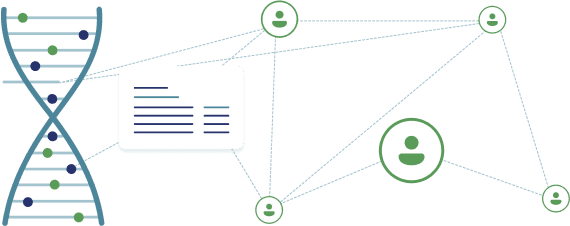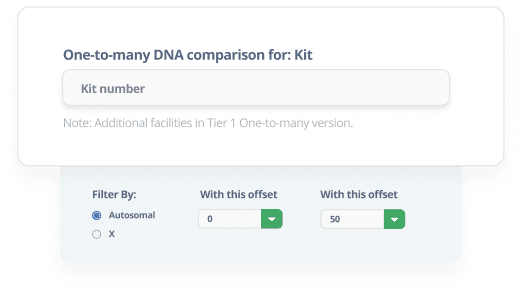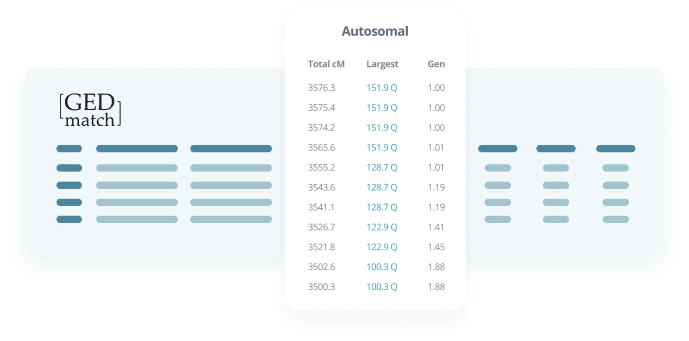
Instantly see your matches
Explore your genealogy
Learn where you come from
Find out if there are any relatives close by

Discover distant relatives within just a few easy steps with GEDmatch’s tools.
You can find out exactly how much DNA you share with your match!


Contact others on your match list after conducting research to determine that match is related to you!
You only need your kit number which is provided when you upload your DNA information to GEDmatch. Simply copy your kit number to the top bar of the “One-to-Many” application, press the search button and start getting immediate results.
For first-time users, all of the information present in this giant spreadsheet-type list can be overwhelming. We will help you understand your One-to-Many results so that you can feel confident and comfortable reading them.
To use the tool, log into your dashboard and click on the kit number next to the name of the person whose kit you would like to analyze.
If you only have one kit, click on your kit number and press the green “Submit” button on the next screen.
Alternatively, you can click on “One-To-Many Limited Version” under the “Free Tools” section about halfway down the right side of the screen. Enter your kit # to see your results.


The people who appear in your results are other people who have also uploaded their DNA to Gedmatch, and who share some genetic similarities with you. The order in which they appear is based on how much DNA you share with them.
Keep in mind that if you’ve only just uploaded your DNA, it can take a few hours for all the data to be processed by the Gedmatch servers. So if you don’t see any results right away, don’t worry – they’ll show up eventually!
The email, kit number and name column are self-explanatory, but what about the other stuff? If you find that you can’t see all of the columns on your screen at once, try zooming out by pressing “ctrl + c”. This should give you a better view.
A centimorgan is a way to measure how much DNA you share with someone else.
If you receive a DNA match that shares 34 cMs across 3 segments, this indicates that you share a total of 34 centimorgans of DNA with that person. You also share a total of three DNA segments.
The amount of DNA you share with your match is called the “largest seg.” This measurement is taken in centimorgans and tells you how much of your DNA is identical to your match.
The total length of all the segments you share with your DNA match is measured in centimorgans. This is the amount of DNA that you have in common with your match.
When looking at your DNA match, the overlap column tells you how many SNPs (single nucleotide polymorphisms) you share with that person. A higher number of shared SNPs usually indicates a closer genetic relationship. However, if the overlap number is highlighted in pink, it may be an indication of a less accurate match.
A link will show up in this column if the kit owner has also linked to an online Wiki Tree or uploaded a Gedcom family tree file.
A link will show up in this column if the kit owner has also linked to an online Wiki Tree or uploaded a Gedcom family tree file.
A maternal haplogroup is a group of mitochondrial DNA (mtDNA) that can be traced back to a single common ancestor. This group is passed down from mother to child. The Maternal Haplogroup report tells you about your maternal-line ancestors. Both men and women can have an mtDNA Haplogroup
A Y DNA test, like the mtDNA test, may pinpoint the paternal line’s origins back thousands of years. Similar to the mtDNA test, there is no way to determine if your shared paternal ancestor was two generations ago (like a grandpa) or 20 generations ago
If you have X DNA in common with your match, you will be able to see the total centimorgans shared. X DNA can provide unique insights into your ancestry and family history. By understanding how X DNA is inherited, you can figure out how you are related to your match.
You can find out how much DNA you share with your match by looking at the size of the largest segment of X DNA. This is different from the total amount of DNA you have in common.
Stay up to date with the latest trends with tips, tricks, and tools from our community of experts!
Resources
Email
support@gedmatch.com
Address
11111 Flintkote Avenue
San Diego, CA 92121